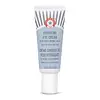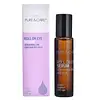What's inside
What's inside
 Key Ingredients
Key Ingredients

 Benefits
Benefits

 Concerns
Concerns

No concerns
 Ingredients Side-by-side
Ingredients Side-by-side

Water
Skin ConditioningEthylhexyl Olivate
Skin ConditioningPrunus Armeniaca Kernel Oil
MaskingButylene Glycol
HumectantCetyl Alcohol
EmollientGlycerin
HumectantMangifera Indica Seed Butter
Skin ConditioningSodium Acrylates Crosspolymer-2
AbsorbentCetyl Phosphate
EmulsifyingCaffeine
Skin ConditioningSqualane
EmollientHyaluronic Acid
HumectantPanthenol
Skin ConditioningCucumis Sativus Fruit Extract
EmollientAvena Sativa Bran Extract
AbrasiveAloe Barbadensis Leaf Juice
Skin ConditioningCamellia Sinensis Leaf Extract
AntimicrobialColloidal Oatmeal
AbsorbentChrysanthemum Parthenium Extract
Skin ConditioningGlycyrrhiza Glabra Root Extract
BleachingCitrus Aurantium Dulcis Peel Extract
Emulsion StabilisingCaprylic/Capric Triglyceride
MaskingCaprylyl Glycol
EmollientSodium Phytate
Sodium Polyglutamate
HumectantC20-22 Alkyl Phosphate
Emulsifying1,2-Hexanediol
Skin ConditioningC20-22 Alcohols
Emulsion StabilisingHydroxyacetophenone
AntioxidantPropanediol
SolventPhenoxyethanol
PreservativePotassium Hydroxide
BufferingWater, Ethylhexyl Olivate, Prunus Armeniaca Kernel Oil, Butylene Glycol, Cetyl Alcohol, Glycerin, Mangifera Indica Seed Butter, Sodium Acrylates Crosspolymer-2, Cetyl Phosphate, Caffeine, Squalane, Hyaluronic Acid, Panthenol, Cucumis Sativus Fruit Extract, Avena Sativa Bran Extract, Aloe Barbadensis Leaf Juice, Camellia Sinensis Leaf Extract, Colloidal Oatmeal, Chrysanthemum Parthenium Extract, Glycyrrhiza Glabra Root Extract, Citrus Aurantium Dulcis Peel Extract, Caprylic/Capric Triglyceride, Caprylyl Glycol, Sodium Phytate, Sodium Polyglutamate, C20-22 Alkyl Phosphate, 1,2-Hexanediol, C20-22 Alcohols, Hydroxyacetophenone, Propanediol, Phenoxyethanol, Potassium Hydroxide
Water
Skin ConditioningPropanediol
SolventSnail Secretion Filtrate
Skin ConditioningGlycerin
HumectantCorn Gluten Amino Acids
Skin ConditioningButylene Glycol
HumectantAloe Barbadensis Leaf Extract
EmollientSodium Polyglutamate
HumectantOligopeptide-1
Skin ConditioningOligopeptide-2
Skin ConditioningOligopeptide-5
Skin ConditioningSilk Extract
Skin ConditioningCollagen
MoisturisingHyaluronic Acid
HumectantAvena Sativa Kernel Extract
AbrasiveYeast Ferment Extract
Skin ConditioningPolygonum Cuspidatum Root Extract
AntioxidantCamellia Sinensis Leaf Extract
AntimicrobialChamomilla Recutita Flower Extract
MaskingGlycyrrhiza Glabra Root Extract
BleachingRosmarinus Officinalis Leaf Extract
AntimicrobialScutellaria Baicalensis Root Extract
AstringentPortulaca Oleracea Extract
Skin ConditioningCentella Asiatica Extract
CleansingSodium Hyaluronate
HumectantBeta-Glucan
Skin ConditioningPropylene Glycol
HumectantHexylene Glycol
EmulsifyingXanthan Gum
Emulsifying1,2-Hexanediol
Skin ConditioningHydroxyacetophenone
AntioxidantEthylhexylglycerin
Skin ConditioningPhenoxyethanol
PreservativePotassium Sorbate
PreservativeSodium Hydroxide
BufferingWater, Propanediol, Snail Secretion Filtrate, Glycerin, Corn Gluten Amino Acids, Butylene Glycol, Aloe Barbadensis Leaf Extract, Sodium Polyglutamate, Oligopeptide-1, Oligopeptide-2, Oligopeptide-5, Silk Extract, Collagen, Hyaluronic Acid, Avena Sativa Kernel Extract, Yeast Ferment Extract, Polygonum Cuspidatum Root Extract, Camellia Sinensis Leaf Extract, Chamomilla Recutita Flower Extract, Glycyrrhiza Glabra Root Extract, Rosmarinus Officinalis Leaf Extract, Scutellaria Baicalensis Root Extract, Portulaca Oleracea Extract, Centella Asiatica Extract, Sodium Hyaluronate, Beta-Glucan, Propylene Glycol, Hexylene Glycol, Xanthan Gum, 1,2-Hexanediol, Hydroxyacetophenone, Ethylhexylglycerin, Phenoxyethanol, Potassium Sorbate, Sodium Hydroxide
 Reviews
Reviews

Ingredients Explained
These ingredients are found in both products.
Ingredients higher up in an ingredient list are typically present in a larger amount.
1,2-Hexanediol is a synthetic liquid and another multi-functional powerhouse.
It is a:
- Humectant, drawing moisture into the skin
- Emollient, helping to soften skin
- Solvent, dispersing and stabilizing formulas
- Preservative booster, enhancing the antimicrobial activity of other preservatives
Butylene Glycol (or BG) is used within cosmetic products for a few different reasons:
Overall, Butylene Glycol is a safe and well-rounded ingredient that works well with other ingredients.
Though this ingredient works well with most skin types, some people with sensitive skin may experience a reaction such as allergic rashes, closed comedones, or itchiness.
Learn more about Butylene GlycolCamellia Sinensis Leaf Extract is derived from the leaves of the tea plant. Black tea, green tea, and oolong tea are all harvested from this plant.
This ingredient has many skin benefits:
This ingredient contains polyphenols, a strong antioxidant. Antioxidants help fight off molecules that damage skin cells.
On top of that, the antioxidants in green tea neutralize free-radicals from the sun. This gives the skin some extra UV protection, but should not replace sunscreen.
Many components of tea have anti-inflammatory properties.
Polyphenols and L-theanine help soothe the skin and reduce irritation. The caffeine in Camellia Sinensis Leaf Extract helps calm inflamed blood vessels.
Other compounds found in tea include: Vitamin Bs, linoleic acid, magnesium, calcium, iron, and zinc.
Research has shown both drinking Camellia Sinensis Leaf Tea and applying it to the skin can help boost skin elasticity and hydration. Studies also show using tea extract may reduce sebum, or oil, production.
Learn more about Camellia Sinensis Leaf ExtractGlycerin is already naturally found in your skin. It helps moisturize and protect your skin.
A study from 2016 found glycerin to be more effective as a humectant than AHAs and hyaluronic acid.
As a humectant, it helps the skin stay hydrated by pulling moisture to your skin. The low molecular weight of glycerin allows it to pull moisture into the deeper layers of your skin.
Hydrated skin improves your skin barrier; Your skin barrier helps protect against irritants and bacteria.
Glycerin has also been found to have antimicrobial and antiviral properties. Due to these properties, glycerin is often used in wound and burn treatments.
In cosmetics, glycerin is usually derived from plants such as soybean or palm. However, it can also be sourced from animals, such as tallow or animal fat.
This ingredient is organic, colorless, odorless, and non-toxic.
Glycerin is the name for this ingredient in American English. British English uses Glycerol/Glycerine.
Learn more about GlycerinGlycyrrhiza Glabra Root Extract is an extract of the roots of Licorice. It has been found to have several benefits such as skin hydrating, conditioning, and soothing.
One component, glabridin, has extra potent antioxidant and soothing properties. It has also been found to block pigmentation from UVB rays in guinea pigs.
Licorice Root also contains a flavonoid. Flavonoids are a natural substance from in plants. Flavonoids also have antioxidant properties.
Another component, glycyrrhizin, has been found to have anti-inflammatory and antimicrobial benefits. This may make licorice root extract effective at treating acne. However, more research is needed to support this.
Liquiritin is one of the flavone compounds found in licorice. It has been found to help lighten skin by preventing tyrosinase from reacting with tyrosine. When the two react, protein is converted to melanin. Melanin is the substance in your body that gives your features pigmentation.
Learn more about Glycyrrhiza Glabra Root ExtractHyaluronic acid is naturally found in healthy skin. It is a humectant, meaning it draws moisture to your skin.
This ingredient helps hydrate, soothe, and protect the skin.
What makes hyaluronic acid so hydrating? It has the capacity to bind or hold large amounts of water.
Fun fact: It is already naturally found in our bodies, such as the fluids of our eyes and our joints.
Studies find this ingredient to have anti-inflammatory and anti-microbial properties. This can help speed up wound-healing.
Hyaluronic acid can be irritating if the molecule has a low-molecular weight, or if the molecules are small.
One study found low-molecular weight hyaluronic acid to be pro-inflammatory, meaning some people may experience irritation. This is because our bodies use hyaluronic acid in the wound-healing process to signal to our bodies, via irritation, that something needs healing.
The same study found high-molecular weight hyaluronic acid to be anti-inflammatory.
These are some other common types of Hyaluronic Acid:
Learn more about Hyaluronic AcidHydroxyacetophenone is antioxidant with skin conditioning and soothing properties. It also boosts the efficiency of preservatives.
This ingredient is not irritating or sensitizing.
Phenoxyethanol is a preservative that has germicide, antimicrobial, and aromatic properties. Studies show that phenoxyethanol can prevent microbial growth. By itself, it has a scent that is similar to that of a rose.
It's often used in formulations along with Caprylyl Glycol to preserve the shelf life of products.
Propanediol is an all-star ingredient. It softens, hydrates, and smooths the skin.
It’s often used to:
Propanediol is not likely to cause sensitivity and considered safe to use. It is derived from corn or petroleum with a clear color and no scent.
Learn more about PropanediolWe don't have a description for Sodium Polyglutamate yet.
Water. It's the most common cosmetic ingredient of all. You'll usually see it at the top of ingredient lists, meaning that it makes up the largest part of the product.
So why is it so popular? Water most often acts as a solvent - this means that it helps dissolve other ingredients into the formulation.
You'll also recognize water as that liquid we all need to stay alive. If you see this, drink a glass of water. Stay hydrated!
Learn more about Water